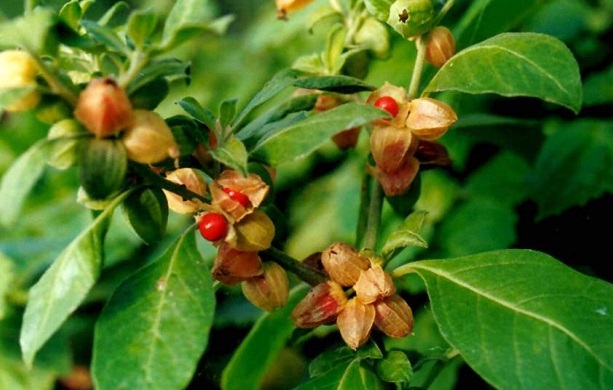Withaferin A from the Ashwagandha plant can help reduce muscle loss caused by angiotensin II
Nikhil Prasad Fact checked by:Thailand Medical News Team Feb 10, 2025 2 months, 3 days, 8 hours, 5 minutes ago
Medical News: Scientists Discover Potential Treatment for Muscle Wasting
Researchers from the University of Louisville in the United States have identified a promising natural compound that may help reduce muscle loss caused by angiotensin II, a protein linked to muscle wasting in various diseases. The phytochemical compound, known as Withaferin A, is derived from the Ashwagandha plant and has previously been recognized for its anti-inflammatory and anti-cancer properties.
 Withaferin A from the Ashwagandha plant can help reduce muscle loss caused by angiotensin II
Withaferin A from the Ashwagandha plant can help reduce muscle loss caused by angiotensin II
Muscle loss, also known as cachexia, is a severe condition that affects millions of people worldwide. It is common in cancer patients and those suffering from chronic illnesses such as kidney disease, heart failure, and other inflammatory disorders. Current treatments for cachexia are limited, making new discoveries like this particularly significant. This
Medical News report highlights how Withaferin A could provide new hope for patients struggling with muscle loss.
Understanding Muscle Wasting and the Role of Angiotensin II
Cachexia is a complex condition marked by extreme muscle wasting and weakness. It is often seen in patients with serious illnesses and contributes to poor quality of life and higher mortality rates. One of the biological triggers of cachexia is angiotensin II, a hormone that plays a role in regulating blood pressure but also promotes inflammation and muscle deterioration when present at high levels.
To study the effects of angiotensin II on muscle loss, scientists developed a model where mice were continuously exposed to the hormone. They observed significant reductions in muscle strength and mass, along with increased inflammation and cellular stress. However, when the mice were treated with Withaferin A, these harmful effects were reversed.
Key Findings of the Study
The research demonstrated several important effects of Withaferin A on muscle health:
-Restoring Muscle Strength: Mice that received Withaferin A showed a noticeable improvement in grip strength, a key measure of muscle function.
-Preserving Muscle Mass: Muscle loss in the tibialis anterior, gastrocnemius, and quadriceps femoris muscles was significantly reduced with treatment.
-Reducing Inflammation: The levels of inflammatory markers such as TNF-α, IL-6, and IL-18 were found to be much lower in treated mice compared to untreated ones.
-Targeting the NLRP3 Inflammasome: Withaferin A inhibited the activation of the NLRP3 inflammasome, a major contributor to inflammation-driven muscle wasting.
-Preventing Protein Breakdown: The compound suppressed the expression of key muscle-wasting genes, including MuRF1 and MAFbx, which are responsible for breaking down muscle proteins.
;
-Supporting Muscle Regeneration: Withaferin A promoted the activity of muscle repair genes such as Pax7 and MyoD, suggesting it could help regenerate lost muscle tissue.
How Withaferin A Works
The study revealed that Withaferin A works by targeting multiple pathways involved in muscle degradation. It reduces inflammation, blocks harmful proteins that cause muscle breakdown, and stimulates the body’s natural muscle repair mechanisms. By addressing these factors, the compound has the potential to not only slow down muscle loss but also promote recovery in patients experiencing severe muscle atrophy.
These findings suggest that Withaferin A could be a breakthrough in the treatment of cachexia and muscle-wasting diseases. However, more research, including clinical trials in humans, will be needed to determine its safety and effectiveness in medical treatments.
Future Implications and Conclusions
The discovery of Withaferin A’s role in combating muscle wasting is an exciting development in medical science. If further research confirms its benefits in human patients, this compound could lead to new treatments for individuals suffering from cachexia due to cancer, heart disease, or chronic inflammation.
One of the most significant aspects of this research is that Withaferin A is derived from a natural source, which may make it a safer alternative compared to synthetic drugs. Additionally, its ability to target multiple causes of muscle wasting makes it a powerful candidate for future therapeutic use.
The study findings were published in the peer-reviewed journal: Cells.
https://www.mdpi.com/2073-4409/14/4/244
For the latest on Herbs and Phytochemicals, keep on logging to Thailand
Medical News.
Read Also:
https://www.thailandmedical.news/news/restoring-muscle-strength-in-women-after-covid-19-through-physiotherapy
https://www.thailandmedical.news/news/canadian-scientists-alarmingly-find-that-weight-loss-drugs-ozempic-and-wegovy-cause-heart-muscles-to-shrink
https://www.thailandmedical.news/articles/herbs-and-phytochemicals
